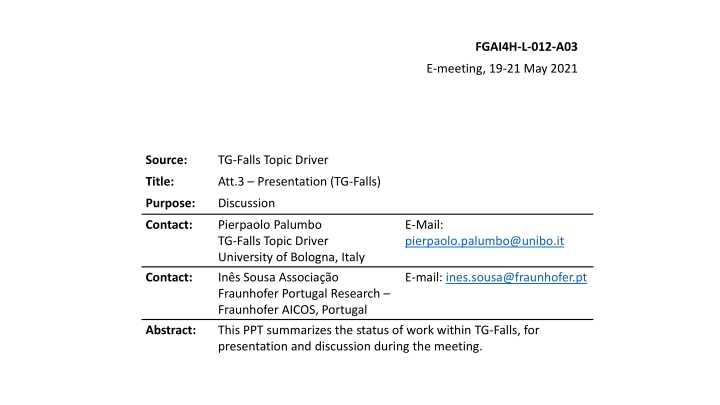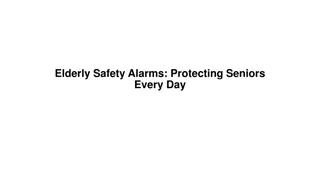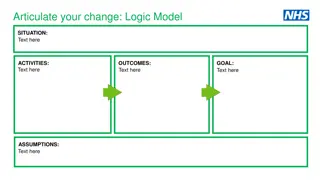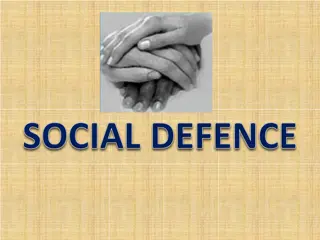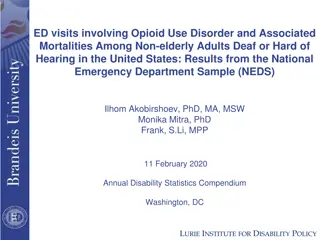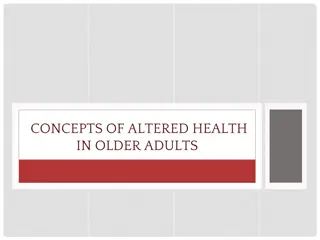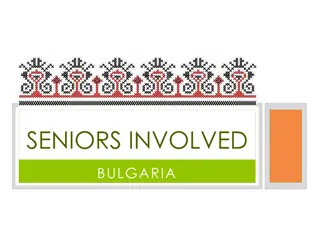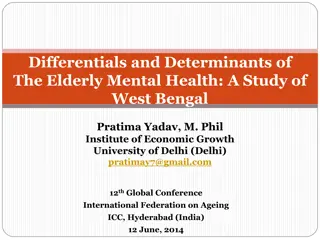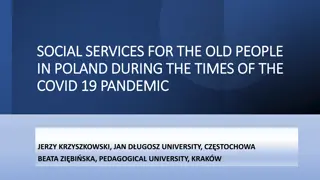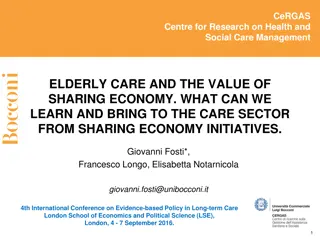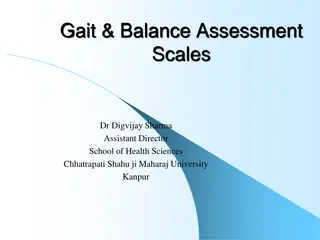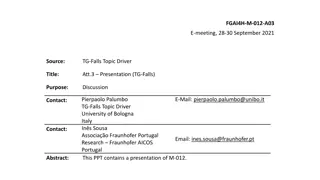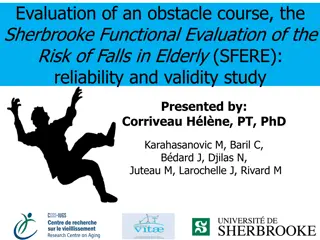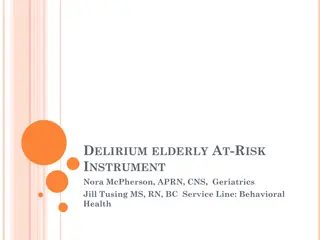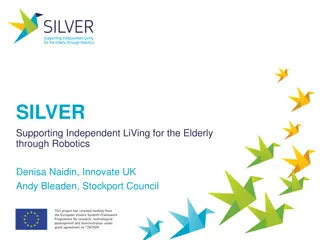AI in Fall Prevention Among the Elderly: Overview & Progress Report
Falls among the elderly are a significant concern globally, with preventable factors causing a substantial burden. This presentation outlines the work of TG-Falls, focusing on AI applications for fall prediction and detection. Key topics covered include the group's purpose, contributors, AI tasks, state of the art in fall prediction tools, and potential impacts. The discussion aims to advance strategies for reducing fall risk among the elderly population.
Download Presentation

Please find below an Image/Link to download the presentation.
The content on the website is provided AS IS for your information and personal use only. It may not be sold, licensed, or shared on other websites without obtaining consent from the author.If you encounter any issues during the download, it is possible that the publisher has removed the file from their server.
You are allowed to download the files provided on this website for personal or commercial use, subject to the condition that they are used lawfully. All files are the property of their respective owners.
The content on the website is provided AS IS for your information and personal use only. It may not be sold, licensed, or shared on other websites without obtaining consent from the author.
E N D
Presentation Transcript
FGAI4H-L-012-A03 E-meeting, 19-21 May 2021 Source: TG-Falls Topic Driver Title: Att.3 Presentation (TG-Falls) Purpose: Discussion Contact: Pierpaolo Palumbo TG-Falls Topic Driver University of Bologna, Italy E-Mail: pierpaolo.palumbo@unibo.it Contact: In s Sousa Associa o Fraunhofer Portugal Research Fraunhofer AICOS, Portugal E-mail: ines.sousa@fraunhofer.pt Abstract: This PPT summarizes the status of work within TG-Falls, for presentation and discussion during the meeting.
AI4H TG-Falls among the elderly 21st May 2021
Outline Introduction About the topic group Subtopic, AI task State of the art Benchmarking platform System architecture AI input and output Score metrics Benchmarking process Dataset acquisition Next steps
Introduction Falls are common, multifactorial, burdensome Falls are preventable (RR 0.7-0.8) falls Global Burden of Disease, 2019, https://vizhub.healthdata.org/
About the topic group Meeting B (Lausanne) meeting L (e-meeting) fgai4htgfalls@lists.itu.int People (contributors or showing interest) In s Sousa, Fraunhofer AICOS, Portugal Pierpaolo Palumbo, University of Bologna, Italy Stefania Bandinelli, SOC Geriatria USL Toscana Centro, Italy Barry Greene, Chief Technology Officer, Kinesis Health Technologies, Ireland Arnab Paul, CEO Patient Planet, WHO Roster of Expert DigitalHealth, India Salman Khan, Assistant Professor in the department of electrical engineering, University of Engineering and Technology Peshawar, Pakistan Kim van Schooten, PhD, Human Frontier Science Program Postdoctoral Fellow, Conjoint Senior Lecturer, UNSW Medicine, UNSW Ageing Futures Institute, Australia
Subtopic, AI tasks Fall prediction: Subject-specific risk score of falling, within a given time window in the future, given information about the subject s risk factors for falls and/or their balance or motor ability Fall detection
State of the art Traditional tools: Timed Up and Go Test (TUG), Tinetti Scale Guidelines (AGS/BGS, NICE, etc.) screening algorithms Different AI models proposed Clinical variables Sensor variables Few models validated (AUC 0.62-0.69) Potential impact: decrease of 15-20% NNT AUC = 0.57 (0.54-0.59) [1] D. Schoene et al., J. Am. Geriatr. Soc., 2013 [2] E. Barry et al., BMC Geriatr., 2014 [3] Panel of Falls in Older Persons American Geriatrics Society and British Geriatrics Society, J. Am. Geriatr. Soc., 2011 [4] A. Tiedemann, et al. Inj. Prev., 2012. [5] P. Palumbo et al., J. Am. Med. Dir. Assoc., 2016. [6] G. V. Gade et al., BMJ Open, 2021 [7] P. Palumbo et al., Aging Clin. Exp. Res., 2018
Benchmarking platform System architecture AI system m AI system 1 AI system 2 Including reference screening algorithms (e.g. time for TUG) Dataset 1 Harmonization scripts Dataset 2 Benchmarking platform Dataset n [??????????? ??????? ????????,?? ???????] Performance matrix Result publication
Benchmarking platform System architecture Harmonization script i Harmonized dataset i Dataset i Records Identified set of risk factors (age, sex, comorbidities, drugs, etc.) Sensor signals (TUG, quiet standing, etc.) .csv, .dta, .sav, .sas7bdat, .Rdata AI input Number of falls experienced in a given time window after baseline assessment [3] Label [1] https://g2aging.org/ [2] Deandrea, S., Lucenteforte, E., Bravi, F., Foschi, R., La Vecchia, C., & Negri, E. (2010). Risk Factors for Falls in Community-dwelling Older People: A Systematic Review and Meta-analysis. Epidemiology, 21(5), 658 668. [3] Lamb, S. E., J rstad-Stein, E. C., Hauer, K., & Becker, C. (2005). Development of a common outcome data set for fall injury prevention trials: the Prevention of Falls Network Europe consensus. Journal of the American Geriatrics Society, 53(9), 1618 1622. https://doi.org/10.1111/j.1532-5415.2005.53455.x
System architecture Different systematic reviews already identified (e.g. [2]) Harmonization script i Harmonized dataset i Dataset i Records Identified set of risk factors (age, sex, comorbidities, drugs, etc.) Sensor signals (TUG, quiet standing, etc.) .csv, .dta, .sav, .sas7bdat, .Rdata AI input Most datasets will not have IMU signals Number of falls experienced in a given time window after baseline assessment [3] Most datasets are already partly harmonized [1] (see effort by RAND Corporation) Critical harmonization Label [1] https://g2aging.org/ [2] Deandrea, S., Lucenteforte, E., Bravi, F., Foschi, R., La Vecchia, C., & Negri, E. (2010). Risk Factors for Falls in Community-dwelling Older People: A Systematic Review and Meta-analysis. Epidemiology, 21(5), 658 668. [3] Lamb, S. E., J rstad-Stein, E. C., Hauer, K., & Becker, C. (2005). Development of a common outcome data set for fall injury prevention trials: the Prevention of Falls Network Europe consensus. Journal of the American Geriatrics Society, 53(9), 1618 1622. https://doi.org/10.1111/j.1532-5415.2005.53455.x
Benchmarking platform AI input and output Either: the probability of falling at least once in a future time window the expected number of falls in a future time window an ordered, fuzzy label for the risk of falling (e.g., low, medium, high) Optionally, suggestions on possible preventive actions to take Identified set of risk factors (age, sex, comorbidities, drugs, etc.) [2] Sensor signals (TUG, quiet standing, etc.) AI input AI output Number of falls experienced in a given time window after baseline assessment [3] Label
Benchmarking platform Scores and metrics Either: the probability of falling at least once in a future time window the expected number of falls in a future time window an ordered, fuzzy label for the risk of falling (e.g., low, medium, high) Optionally, suggestions on possible preventive actions to take Identified set of risk factors (age, sex, comorbidities, drugs, etc.) [2] Sensor signals (TUG, quiet standing, etc.) AI input AI output Number of falls experienced in a given time window after baseline assessment [3] Label [??????????? ??????? ????????,?? ???????] Multiple figures of merit Discriminative ability (AUC), calibration (calibration curves, 2, MSE) (No calibration indices if AI output is not probabilistic)
Benchmarking platform Benchmarking process The applicants receive information on the AI task, datasets, documentation The applicants submit their AI algorithms to test and a declaration of not having accessed those data before Q: how much this process will be shared among all TGs of the FG? Technological platform Rules Time schedule Result publication
Benchmarking platform Dataset acquisition Study Country N Clinical, sensor data Available to us FallSensing Portugal 400 Clin + sensor Yes InCHIANTI Italy 800 Clin + sensor Not yet HRS USA 20,900 Clin Yes MHAS Mexico 14,700 Clin Yes ELSA UK 10,000 Clin Not yet SHARE Europe + Israel 77,000 Clin Yes KLoSA Korea 6,900 Clin Yes HRS family IFLS Indonesia ? Clin Not yet TILDA Ireland 6,400 Clin Not yet CHARLS China 19,800 Clin Not yet LASI India 72,000 Clin Yes [1] A. C. Martins et al., JMIR Res. Protoc., 2018. [2] L. Ferrucci et al., J. Am. Geriatr. Soc., 2000. http://inchiantistudy.net/wp/ [3] https://g2aging.org/ Gateway to Global Aging Data, Produced by the Program on Global Aging, Health & Policy, University of Southern California with funding from the National Institute on Aging (R01 AG030153) CRELES Costa Rica 2,000 Clin Yes ELSI Brazil ? Clin Not yet MARS Malesia 6,000 Clin Not yet JSTAR Japan 4,000 Clin Not yet
Benchmarking platform Dataset acquisition Study Country N Clinical, sensor data Available to us Info for applications Details on data handling and processing Time schedule FallSensing Portugal 400 Clin + sensor Yes InCHIANTI Italy 800 Clin + sensor Not yet HRS USA 20,900 Clin Yes MHAS Mexico 14,700 Clin Yes ELSA UK 10,000 Clin Not yet SHARE Europe + Israel 77,000 Clin Yes KLoSA Korea 6,900 Clin Yes HRS family IFLS Indonesia ? Clin Not yet TILDA Ireland 6,400 Clin Not yet CHARLS China 19,800 Clin Not yet LASI India 72,000 Clin Yes [1] A. C. Martins et al., JMIR Res. Protoc., 2018. [2] L. Ferrucci et al., J. Am. Geriatr. Soc., 2000. http://inchiantistudy.net/wp/ [3] https://g2aging.org/ Gateway to Global Aging Data, Produced by the Program on Global Aging, Health & Policy, University of Southern California with funding from the National Institute on Aging (R01 AG030153) CRELES Costa Rica 2,000 Clin Yes ELSI Brazil ? Clin Not yet MARS Malesia 6,000 Clin Not yet JSTAR Japan 4,000 Clin Not yet
Next steps Increase intra-TG collaboration, collaboration with WGs Complete the TDD Applications for data access Harmonization scripts EU Falls Festival April 4-5, 2022
